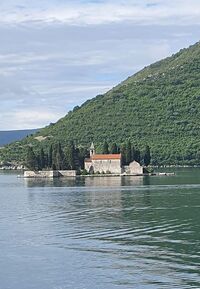Photo. "Our Lady of the Rocks" stands on a small island outside Perast in Montenegro. © Travel Explorations.
Observed the catholic church on Our Lady of the Rocks from the harbour and hillside. This is one of the two islets off the coast of Perast in the Bay of Kotor in Montenegro.
The method of building the island over such a long period a still a mystery. The small island outside Perast, Montenegro, is known for its historic church called "Our Lady of the Rocks" (Gospa od Škrpjela). This man-made island is one of two located in the Bay of Kotor, the other being Saint George Island (Sveti Đorđe). The exact method how to build and maintain the island over such a long period is not clearly defined. Hopefully the church stands on a safe ground.
There are also several intriguing aspects and legends associated with this island that contribute to its aura of mystery. According to a legend, the island was created over centuries by local seamen who, upon returning from each successful voyage, laid a rock in the bay. This tradition, known as "Fašinada," continues to this day with an annual event where local people throw rocks into the sea. The icon of the Madonna and Child found by the sailors is believed to have miraculous powers. Numerous legends speak of its role in protecting sailors and ensuring their safe return from dangerous voyages. This has made the church a pilgrimage site for those seeking divine protection.
There are various tales of unexplained events associated with the church. For example, some locals and visitors have reported seeing mysterious lights around the island, especially during the night, which are often attributed to the presence of the Virgin Mary. These sightings add a layer of supernatural mystery to the site.
Local legends also speak of hidden treasures and secrets buried on the island or within the church. Some believe that the island hides artifacts of immense value and historical significance, waiting to be discovered. The church’s museum, filled with maritime artifacts, votive tablets, and other historical items, only fuels these speculations.
Our Lady of the Rocks is an important pilgrimage site for the region. Many visit the island to pray for protection and blessings, particularly those with connections to the sea.
The current church was constructed in 1632 and underwent significant renovations in 1722. The church is built in the Byzantine style, with a single nave and a distinctive dome. The interior features a variety of Baroque decorations and paintings. The church houses numerous works of art, including paintings by the famous Baroque artist Tripo Kokolja, who was from Perast. His most notable contribution is the large ceiling painting depicting the Assumption of the Virgin.
The "Fašinada" event is held on July 22nd each year, where locals and visitors gather to throw rocks into the sea around the island, continuing the tradition of expanding and maintaining the island.
Saint George Island (Sveti Đorđe) is the natural island next to Our Lady of the Rocks. It is home to a 12th-century Benedictine monastery and a historic cemetery for the old nobility from Perast. The islands can be reached by boat from Perast, with numerous local operators offering trips to and from the islands.
Both islands are popular tourist destinations due to their historical, cultural, and scenic significance. The views of the Bay of Kotor and the surrounding mountains from the islands are particularly stunning. These islands are a testament to the rich maritime history and cultural heritage of Montenegro, offering visitors a unique glimpse into the region's past.
Stein Morten Lund, May 2024
Additional information
This article is written with assistance from ChatGTP and use of background information from sources as Wikipedia.












